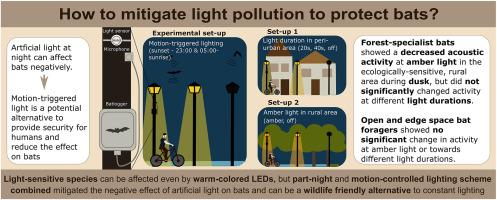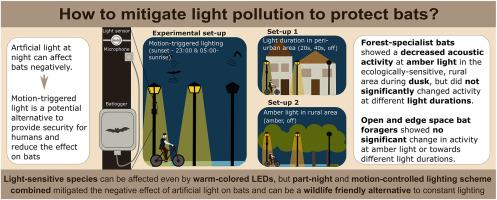通过运动控制LED照明减轻光污染,保护蝙蝠
IF 7.3
2区 环境科学与生态学
Q1 ENVIRONMENTAL SCIENCES
引用次数: 0
摘要
人们越来越认识到光污染是一种影响人类和野生动物的污染物。最近,越来越多的道路和自行车道被运动控制照明,然而,对夜间活动的野生动物,如蝙蝠的不利影响,到目前为止仍然盛行。我们研究了是否可以通过将夜间照明(2300至500小时之间关闭)与运动控制照明和使用暖色发光二极管(led)的短照明间隔相结合来减轻负面影响。在四个月的时间里,我们在两种环境中测量了自行车道上几个部分蝙蝠的声学活动:近郊地区和生态敏感的农村地区。在城市周边区域,我们还测试了20秒的光照间隔是否比40秒的光照间隔对蝙蝠的影响更小。在农村地区,我们测试了琥珀光是否减轻了对敏感森林附属物种的不利影响。在城市周边地区,无论照明时间长短,照明方案都不会对蝙蝠产生负面影响。在农村地区,我们观察到森林专家蝙蝠的活动在黄昏时对琥珀色光的反应减少,而在黎明时则没有。然而,大多数其他蝙蝠物种的活动没有受到影响。我们的结论是,夜间和运动控制照明的结合可以减轻人造光对蝙蝠的负面影响。然而,我们承认我们的研究集中在单一的自行车道上。此外,森林专家蝙蝠对琥珀色光的负面反应强调,即使是暖色的led也会影响对光敏感的物种——当小路被更频繁地使用时,这个问题可能会加剧。使用运动传感器按需管理LED照明,并在半夜完全关闭它,可能是减少自行车道、道路和居民区光污染的有效方法。本文章由计算机程序翻译,如有差异,请以英文原文为准。


Mitigating light pollution through motion-controlled LED lighting to protect bats
Light pollution is increasingly recognised as a pollutant that affects both humans and wildlife. Recently, an increasing number of roads and cycle paths have been illuminated by motion-controlled lighting, yet the adverse effects on nocturnal wildlife, such as bats, have so far prevailed. We investigated whether negative impacts could be mitigated by combining part-night lighting (switch off between 2300 and 500 h) with motion-controlled lighting and short lighting intervals using warm-colored light-emitting diodes (LEDs). Over a four-month period, we measured the acoustic activity of bats in several sections of a cycle path in two environments: a peri-urban area and an ecologically sensitive rural area. In the peri-urban section, we also tested whether 20-s light intervals had a lesser impact on bats than 40-s intervals. In the rural section, we tested whether amber light alleviates the adverse effects on sensitive forest-affiliated species. In the peri-urban area, the lighting scheme did not negatively impact bats, irrespective of the lighting duration. In the rural section, we observed that forest-specialist bat activity decreased in response to amber light at dusk but not at dawn. However, the activity of most other bat species remained unaffected. We conclude that a combination of part-night and motion-controlled lighting may mitigate the negative effects of artificial light on bats. However, we acknowledge that our study focused on a single bicycle trail. Furthermore, the negative response of forest-specialist bats to amber light emphasizes that even warm-colored LEDs can affect light-sensitive species — a problem that is likely to be exacerbated when trails are used more frequently. Using motion sensors to manage LED lighting on demand and switch it off completely in the middle of the night could be an effective way to reduce light pollution along bicycle trails, roads and in residential areas.
求助全文
通过发布文献求助,成功后即可免费获取论文全文。
去求助
来源期刊

Environmental Pollution
环境科学-环境科学
CiteScore
16.00
自引率
6.70%
发文量
2082
审稿时长
2.9 months
期刊介绍:
Environmental Pollution is an international peer-reviewed journal that publishes high-quality research papers and review articles covering all aspects of environmental pollution and its impacts on ecosystems and human health.
Subject areas include, but are not limited to:
• Sources and occurrences of pollutants that are clearly defined and measured in environmental compartments, food and food-related items, and human bodies;
• Interlinks between contaminant exposure and biological, ecological, and human health effects, including those of climate change;
• Contaminants of emerging concerns (including but not limited to antibiotic resistant microorganisms or genes, microplastics/nanoplastics, electronic wastes, light, and noise) and/or their biological, ecological, or human health effects;
• Laboratory and field studies on the remediation/mitigation of environmental pollution via new techniques and with clear links to biological, ecological, or human health effects;
• Modeling of pollution processes, patterns, or trends that is of clear environmental and/or human health interest;
• New techniques that measure and examine environmental occurrences, transport, behavior, and effects of pollutants within the environment or the laboratory, provided that they can be clearly used to address problems within regional or global environmental compartments.
 求助内容:
求助内容: 应助结果提醒方式:
应助结果提醒方式:


